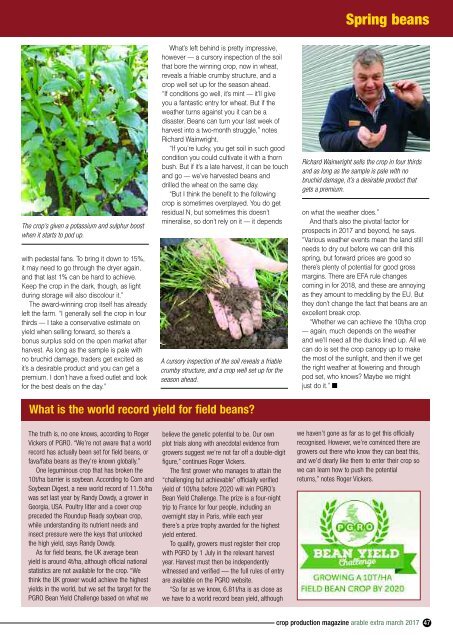In this issue..
CPM-March-Extra-2017
CPM-March-Extra-2017
Create successful ePaper yourself
Turn your PDF publications into a flip-book with our unique Google optimized e-Paper software.
Spring beans<br />
The crop’s given a potassium and sulphur boost<br />
when it starts to pod up.<br />
with pedestal fans. To bring it down to 15%,<br />
it may need to go through the dryer again,<br />
and that last 1% can be hard to achieve.<br />
Keep the crop in the dark, though, as light<br />
during storage will also discolour it.”<br />
The award-winning crop itself has already<br />
left the farm. “I generally sell the crop in four<br />
thirds –– I take a conservative estimate on<br />
yield when selling forward, so there’s a<br />
bonus surplus sold on the open market after<br />
harvest. As long as the sample is pale with<br />
no bruchid damage, traders get excited as<br />
it’s a desirable product and you can get a<br />
premium. I don’t have a fixed outlet and look<br />
for the best deals on the day.”<br />
What’s left behind is pretty impressive,<br />
however –– a cursory inspection of the soil<br />
that bore the winning crop, now in wheat,<br />
reveals a friable crumby structure, and a<br />
crop well set up for the season ahead.<br />
“If conditions go well, it’s mint –– it’ll give<br />
you a fantastic entry for wheat. But if the<br />
weather turns against you it can be a<br />
disaster. Beans can turn your last week of<br />
harvest into a two-month struggle,” notes<br />
Richard Wainwright.<br />
“If you’re lucky, you get soil in such good<br />
condition you could cultivate it with a thorn<br />
bush. But if it’s a late harvest, it can be touch<br />
and go –– we’ve harvested beans and<br />
drilled the wheat on the same day.<br />
“But I think the benefit to the following<br />
crop is sometimes overplayed. You do get<br />
residual N, but sometimes <strong>this</strong> doesn’t<br />
mineralise, so don’t rely on it –– it depends<br />
A cursory inspection of the soil reveals a friable<br />
crumby structure, and a crop well set up for the<br />
season ahead.<br />
Richard Wainwright sells the crop in four thirds<br />
and as long as the sample is pale with no<br />
bruchid damage, it’s a desirable product that<br />
gets a premium.<br />
on what the weather does.”<br />
And that’s also the pivotal factor for<br />
prospects in 2017 and beyond, he says.<br />
“Various weather events mean the land still<br />
needs to dry out before we can drill <strong>this</strong><br />
spring, but forward prices are good so<br />
there’s plenty of potential for good gross<br />
margins. There are EFA rule changes<br />
coming in for 2018, and these are annoying<br />
as they amount to meddling by the EU. But<br />
they don’t change the fact that beans are an<br />
excellent break crop.<br />
“Whether we can achieve the 10t/ha crop<br />
–– again, much depends on the weather<br />
and we’ll need all the ducks lined up. All we<br />
can do is set the crop canopy up to make<br />
the most of the sunlight, and then if we get<br />
the right weather at flowering and through<br />
pod set, who knows? Maybe we might<br />
just do it.” ■<br />
What is the world record yield for field beans?<br />
The truth is, no one knows, according to Roger<br />
Vickers of PGRO. “We’re not aware that a world<br />
record has actually been set for field beans, or<br />
fava/faba beans as they’re known globally.”<br />
One leguminous crop that has broken the<br />
10t/ha barrier is soybean. According to Corn and<br />
Soybean Digest, a new world record of 11.5t/ha<br />
was set last year by Randy Dowdy, a grower in<br />
Georgia, USA. Poultry litter and a cover crop<br />
preceded the Roundup Ready soybean crop,<br />
while understanding its nutrient needs and<br />
insect pressure were the keys that unlocked<br />
the high yield, says Randy Dowdy.<br />
As for field beans, the UK average bean<br />
yield is around 4t/ha, although official national<br />
statistics are not available for the crop. “We<br />
think the UK grower would achieve the highest<br />
yields in the world, but we set the target for the<br />
PGRO Bean Yield Challenge based on what we<br />
believe the genetic potential to be. Our own<br />
plot trials along with anecdotal evidence from<br />
growers suggest we’re not far off a double-digit<br />
figure,” continues Roger Vickers.<br />
The first grower who manages to attain the<br />
“challenging but achievable” officially verified<br />
yield of 10t/ha before 2020 will win PGRO’s<br />
Bean Yield Challenge. The prize is a four-night<br />
trip to France for four people, including an<br />
overnight stay in Paris, while each year<br />
there’s a prize trophy awarded for the highest<br />
yield entered.<br />
To qualify, growers must register their crop<br />
with PGRO by 1 July in the relevant harvest<br />
year. Harvest must then be independently<br />
witnessed and verified –– the full rules of entry<br />
are available on the PGRO website.<br />
“So far as we know, 6.81t/ha is as close as<br />
we have to a world record bean yield, although<br />
we haven’t gone as far as to get <strong>this</strong> officially<br />
recognised. However, we’re convinced there are<br />
growers out there who know they can beat <strong>this</strong>,<br />
and we’d dearly like them to enter their crop so<br />
we can learn how to push the potential<br />
returns,” notes Roger Vickers.<br />
crop production magazine arable extra march 2017 47


